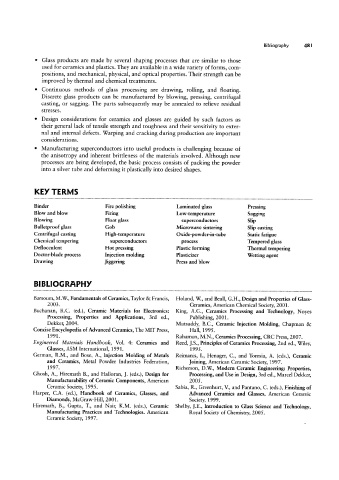Page 501 - 04. Subyek Engineering Materials - Manufacturing, Engineering and Technology SI 6th Edition - Serope Kalpakjian, Stephen Schmid (2009)
P. 501
Bibliography
Glass products are made by several shaping processes that are similar to those
used for ceramics and plastics. They are available in a wide variety of forms, com-
positions, and mechanical, physical, and optical properties. Their strength can be
improved by thermal and chemical treatments.
Continuous methods of glass processing are drawing, rolling, and floating.
Discrete glass products can be manufactured by blowing, pressing, centrifugal
casting, or sagging. The parts subsequently may be annealed to relieve residual
stresses.
Design considerations for ceramics and glasses are guided by such factors as
their general lack of tensile strength and toughness and their sensitivity to exter-
nal and internal defects. Warping and cracking during production are important
considerations.
Manufacturing superconductors into useful products is challenging because of
the anisotropy and inherent brittleness of the materials involved. Although new
processes are being developed, the basic process consists of packing the powder
into a silver tube and deforming it plastically into desired shapes.
KEY TERMS
Binder Fire polishing Laminated glass Pressing
Blow and blow Firing Low-temperature Sagging
Blowing Float glass superconductors Slip
Bulletproof glass Gob Microwave sintering Slip casting
Centrifugal casting High-temperature Oxide-powder-in-tube Static fatigue
Chemical tempering superconductors process Tempered glass
Deflocculent Hot pressing Plastic forming Thermal tempering
Doctor-blade process Injection molding Plasticizer Wetting agent
Drawing _Iiggering Press and blow
BIBLIOGRAPHY
Barsoum, M.W, Fundamentals of Ceramics, Taylor Sc Francis, Holand, W, and Beall, G.H., Design and Properties of Glass
2003. Ceramics, American Chemical Society, 2001.
Buchanan, R.C. (ed.), Ceramic Materials for Electronics: King, A.G., Ceramics Processing and Technology, Noyes
Processing, Properties and Applications, 3rd ed., Publishing, 2001.
Dekker, 2004. Mutsuddy, B.C., Ceramic Injection Molding, Chapman 86
Concise Encyclopedia of Advanced Ceramics, The MIT Press, Hall, 1995.
1991. Rahaman, M.N., Ceramics Processing, CRC Press, 2007.
Engineered Materials Handbook, Vol. 4: Ceramics and Reed, ].S., Principles of Ceramics Processing, 2nd ed., Wiley,
Glasses, ASM International, 1991. 1995.
German, R.M., and Bose, A., Injection Molding of Metals Reimanis, I., Henager, C., and Tomsia, A. (eds.), Ceramic
and Ceramics, Metal Powder Industries Federation, Joining, American Ceramic Society, 1997.
1997. Richerson, DW, Modern Ceramic Engineering: Properties,
Ghosh, A., Hiremath B., and Halloran, ]. (eds.), Design for Processing, and Use in Design, 3rd ed., Marcel Dekker,
Manufacturability of Ceramic Components, American 2005.
Ceramic Society, 1995. Sabia, R., Greenhurt, V, and Pantano, C. (eds.), Finishing of
Harper, C_A. (ed.), Handbook of Ceramics, Glasses, and Advanced Ceramics and Glasses, American Ceramic
Diamonds, McGraw-Hill, 2001. society, 1999.
Hiremath, B., Gupta, T., and Nair, K.M. (eds.), Ceramic Shelby, ].E., Introduction to Glass Science and Technology,
Manufacturing Practices and Technologies. American Royal Society of Chemistry, 2005 .
Ceramic Society, 1997.

